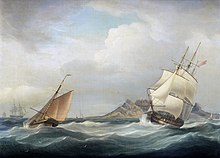Charles Adam
Sir Charles Adam | |
|---|---|
 Admiral Sir Charles Adam | |
| Born | 6 October 1780 |
| Died | 19 September 1853 (aged 72) Greenwich, London |
| Allegiance | |
| Service/ | |
| Years of service | 1790–1847 |
| Rank | Admiral of the Blue |
| Commands held | Sybille Chiffonne Resistance Invincible Impregnable Royal Sovereign North America and West Indies Station Greenwich Hospital |
| Battles/wars | Napoleonic Wars |
| Awards | Knight Commander of the Order of the Bath |

Born at Blairadam House just north of Kelty in Fife he was the second son of William Adam (of Blair Adam) and Eleanora Adam (the daughter of Charles Elphinstone, 10th Lord Elphinstone), Adam joined the Royal Navy in 1790.[1] He served under his maternal uncle, Admiral Lord Keith, in the Mediterranean Fleet and during the capture of the Cape of Good Hope from the Dutch.[1] He was made acting lieutenant by Keith in the third-rate HMS Victorious on the East Indies Station in 1795.[1] Promoted to the substantive rank of lieutenant on 8 February 1798, to commander on 16 May 1798 and to captain on 12 June 1799, Adam was given command of the frigate Sybille.[2] While commanding Sybille, he captured the French Chiffonne under difficult circumstances at Mahé in the Seychelles.[1]
Adam returned from the East Indies in 1802, and on 23 May 1803, was given command of the captured Chiffonne, which operated in the North Sea under Lord Keith until 1805. He commanded the fifth-rate Resistance from 27 August 1805 until 6 April 1810, and from 1811 until 1813, operated off the coast of Spain in command of the third-rate Invincible. He briefly commanded the second-rate Impregnable from 16 May 1814 to 29 June 1814, ending his active service.[2]
Administrative career

After the war, Adam twice commanded the royal yacht,
Adam was promoted
Adam was a friend of Lord Auckland and brother-in-law to Lord Minto, both of whom served as First Lord of the Admiralty during his time in office, fostering a close working relationship. He was also on good terms with Lord Palmerston, the Foreign Secretary.[1]
During his tenure, the
After leaving the Board, Adam resumed a naval command. From 17 August 1841 until 27 December 1844, he was commander-in-chief of the North America and West Indies Station, aboard HMS Illustrious (flag-captain John Erskine).[2] On 24 July 1846, soon after the reappointment of Lord Auckland as First Lord of the Admiralty, he became First Naval Lord (in the First Russell ministry) for the third and last time.[6] He retired the next year, on 20 July 1847, to become Governor of Greenwich Hospital,[10] and was promoted admiral on 8 January 1848.[11]

Adam's brother Francis was the partial owner of the "Nismes" slave plantation in British Guiana. After Francis died on 8 June 1820, a part of the mortgage on the plantation was subsequently transferred into Adam's possession on 25 April 1835. Adam, like Francis, was a judgment creditor and was selected as one of the executors of Francis' will and testament; as a result of the Slavery Abolition Act 1833, slavery was abolished in British Guiana, and Adam claimed £6,405 of compensation from the British government on 25 July 1836 under the terms of the Slave Compensation Act 1837.[12]
Adam died at Greenwich on 16 September 1853.
References
- ^ required.)
- ^ a b c d e f "Biography of Charles Adam R.N." Retrieved 6 January 2013.
- ^ "Former Fellows of The Royal Society of Edinburgh" (PDF). Archived from the original (PDF) on 19 September 2015. Retrieved 3 December 2014.
- ^ "No. 18141". The London Gazette. 28 May 1825. p. 933.
- ^ "No. 18807". The London Gazette. 27 May 1831. p. 1030.
- ^ a b c Sainty, J C (1975). "'Lord High Admiral and Commissioners of the Admiralty 1660–1870', Office-Holders in Modern Britain: Volume 4: Admiralty Officials 1660–1870". pp. 18–31. Retrieved 6 January 2013.
- ^ "No. 19296". The London Gazette. 11 August 1835. p. 1524.
- ^ "No. 19721". The London Gazette. 2 April 1839. p. 724.
- ^ "No. 19456". The London Gazette. 10 January 1837. p. 70.
- ^ "No. 20753". The London Gazette. 13 July 1847. p. 2559.
- ^ "No. 20815". The London Gazette. 14 January 1848. p. 122.
- ^ "Summary of Individual - Legacies of British Slave-ownership". ucl.ac.uk. Retrieved 16 July 2015.
- ^ "Memorial M2378". Maritime memorials. Archived from the original on 22 July 2015. Retrieved 21 July 2015.
- ^ "Answers to Correspondents". The Voice of the North. No. 225. New South Wales, Australia. 10 May 1929. p. 14. Retrieved 9 May 2023 – via National Library of Australia.
External links
- Hansard 1803–2005: contributions in Parliament by Charles Adam
- William Loney RN Career History
- O'Byrne, William Richard (1849). . . John Murray – via Wikisource.

